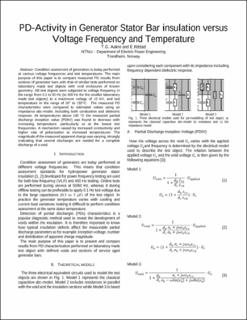PD-Activity in Generator Stator Bar insulation versus Voltage Frequency and Temperature
Chapter
Accepted version

Åpne
Permanent lenke
https://hdl.handle.net/11250/2733332Utgivelsesdato
2020Metadata
Vis full innførselSamlinger
- Institutt for elkraftteknikk [2465]
- Publikasjoner fra CRIStin - NTNU [38070]
Originalversjon
http://dx.doi.org/10.1109/ICD46958.2020.9341874Sammendrag
Condition assessment of generators is today performed at various voltage frequencies and test temperatures. The main purpose of this paper is to compare measured PD results from sections of generator bars with that of similar tests performed on laboratory made test objects with void enclosures of known geometry. The test objects were subjected to ac voltage in the frequency range from 0.1 to 300 Hz, increasing in steps up to a maximum of 10 kV. The measured values of partial discharge inception voltages (PDIV), apparent charge magnitude and number of PDs were compared to estimated values in the temperature range of 20° to 155°C using an impedance abcmodel, including both conduction and dielectric response. It was found that the capacitive abc-model sufficiently accurately describes the observed PDIV values at temperatures below 100°C and test frequencies below 50 Hz. At temperatures higher temperatures the measured PDIV values were found to decrease with increasing temperature, particularly so at the lowest test frequencies. This is in agreement with the assumption of increased conductivity and higher rate of polarization at increased temperatures. The high number of low magnitude PDs, strongly indicating that several discharges are needed for a complete discharge of a void surface.